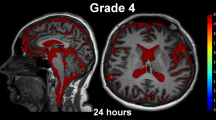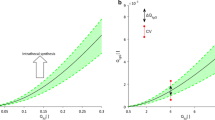Abstract
The rostrocaudal gradient (RCG) of markers present in cerebrospinal fluid (CSF) has not been studied adequately due to lack of appropriate control populations and ethical restrictions. The aim of this study is to understand the rostrocaudal gradient of CSF biomarkers. We contacted a study comparing CSF levels of seven biomarkers from cisternal (rostral) and lumbar (caudal) CSF obtained from patients with trigeminal neuralgia and tension-type headache. The RCGs of CSF/serum albumin ratio, 8-isoprostane. GFAP, total tau and beta amyloid protein were higher than one. The RCGs of lactate, VEGF and the heavy chain of neurofilament protein were lower than one. The study provides new values for several commonly examined markers of cisternal CSF. Knowledge of the RCG gradient of different CSF markers is important in interpreting studies reporting ventricular CSF values.
Similar content being viewed by others
References
Grove J, Schechter PJ, Hanke NF, de Smet Y, Agid Y, Tell G et al (1982) Concentration gradients of free and total gamma-aminobutyric acid and homocarnosine in human CSF: comparison of suboccipital and lumbar sampling. J Neurochem 39(6):1618–1622
Menachem EB, Persson L, Schechter PJ, Haegele KD, Huebert N, Hardenberg J (1989) Cerebrospinal fluid parameters in healthy volunteers during serial lumbar punctures. J Neurochem 52:632–635
Sommer JB, Gaul C, Heckmann J, Neundorfer B, Erbguth FJ (2002) Does lumbar cerebrospinal fluid reflect ventricular cerebrospinal fluid? A prospective study in patients with external ventricular drainage. Eur Neurol 47(4):224–232
Reiber H (1994) Flow rate of cerebrospinal fluid (CSF)–a concept common to normal blood-CSF barrier function and to dysfunction in neurological diseases. J Neurol Sci 122(2):189–203
Reiber H (2003) Proteins in cerebrospinal fluid and blood: barriers, CSF flow rate and source-related dynamics. Restor Neurol Neurosci 21(3):79–96
Hühmer AF, Biringer RG, Amato H, Fonteh AN, Harrington MG (2006) Protein analysis in human cerebrospinal fluid: Physiological aspects, current progress and future challenges. Dis Markers 22(1):3–26
Reiber H (1998) Cerebrospinal fluid–physiology, analysis and interpretation of protein patterns for diagnosis of neurological diseases. Mult Scler 4(3):99–107
Petzold A, Keir G, Green AJE, Giovannoni G, Thompson EJ (2003) A specific ELISA for measuring neurofilament heavy chain phosphoforms. J Immunol Methods 278(1–2):179–190
Petzold A, Keir G, Green AJE, Giovannoni G, Thompson EJ (2004) An ELISA for glial fibrillary acidic protein. J Immunol Methods 287(1–2):169–177
Tarnaris A, Toma AK, Chapman MD, Petzold A, Kitchen ND, Keir G et al (2009) The longitudinal profile of CSF markers during external lumbar drainage. Br Med J 80(10):1130
Petzold A, Brettschneider J, Jin K, Keir G, Murray NM, Hirsch NP et al (2009) CSF protein biomarkers for proximal axonal damage improve prognostic accuracy in the acute phase of Guillain-Barré syndrome. Muscle Nerve 40(1):42–49
Hulstaert F, Blennow K, Ivanoiu A, Schoonderwaldt HC, Riemenschneider M, Deyn PPD et al (1999) Improved discrimination of AD patients using ß-amyloid (1–42) and tau levels in CSF. Neurology 52(8):1555
Reiber H (2001) Dynamics of brain-derived proteins in cerebrospinal fluid. Clinica Chimica Acta 310(2):173–186
Reiber H, Peter JB (2001) Cerebrospinal fluid analysis: disease-related data patterns and evaluation programs. J Neurol Sci 184(2):101–122
Van Gool WA, Schenk DB, Bolhuis PA (1994) Concentrations of amyloid-beta protein in cerebrospinal fluid increase with age in patients free from neurodegenerative disease. Neurosci Lett 172(1–2):122
Kanai M, Matsubara E, Isoe K, Urakami K, Nakashima K, Arai H et al (1998) Longitudinal study of cerebrospinal fluid levels of tau, A beta1-40, and A beta1–42 (43) in Alzheimer’s disease: a study in Japan. Ann Neurol 44(1):17
Pryce JD, Gant PW, Saul KJ (1970) Normal concentrations of lactate, glucose, and protein in cerebrospinal fluid, and the diagnostic implications of abnormal concentrations. Clin Chem 16(7):562
Prockop LD (1968) Cerebrospinal fluid lactic acid. Clearance and effect on facilitated diffusion of a glucose analogue. Neurology 18(2):189
Valenca LM, Shannon DC, Kazemi H (1971) Clearance of lactate from the cerebrospinal fluid. Neurology 21(6):615–620
Vámosi B, Diószeghy P, Molnar L (1983) Lactate and pyruvate content of the human cisternal cerebrospinal fluid. Normal values, age and sex dependency, correlations with glucose concentrations. Archiv für Psychiatrie und Nervenkrankheiten 232(6):521
Posner JB, Plum F (1967) Independence of blood and cerebrospinal fluid lactate. Arch Neurol 16(5):492
Brettschneider J, Petzold A, Schottle D, Claus A, Riepe M, Tumani H (2006) The neurofilament heavy chain (NfH) in the cerebrospinal fluid diagnosis of Alzheimer’s disease. Dement Geriatr Cogn Disord 21(5–6):291–295
DeGiorgio LA, Sheu KF, Blass JP (1994) Culture from human leptomeninges of cells containing neurofilament protein and neuron-specific enolase. J Neurol Sci 124(2):141
Silverberg G, Caralopoulos I, Saul T, Slone S, Miller M, Messier A et al (2009) Amyloid and tau accumulation precede CSF production decline in normal aging. Cerebrospinal Fluid Res 6(Suppl 1):S38
Hamano T, Yoshimura M, Yamazaki T, Shinkai Y, Yanagisawa K, Kuriyama M et al (1997) Amyloid [beta]-protein (A [beta]) Accumulation in the Leptomeninges during Aging and in Alzheimer Disease. J Neuropathol Exp Neurol 56(8):922
Shinkai Y, Yoshimura M, Morishima-Kawashima M, Ito Y, Shimada H, Yanagisawa K et al (1997) Amyloid -protein deposition in the leptomeninges and cerebral cortex. Ann Neurol 42(6):899–908
Hart MN, Merz P, Bennett-Gray J, Menezes AH, Goeken JA, Schelper RL et al (1988) beta-amyloid protein of Alzheimer’s disease is found in cerebral and spinal cord vascular malformations. Am J Pathol 132(1):167
Horowitz S, Thomas C, Gruener G, Nand S, Shea JF (1998) MR of leptomeningeal spinal and posterior fossa amyloid. AJNR Am J Neuroradiol 19(5):900
Bateman RJ, Wen G, Morris JC, Holtzman DM (2007) Fluctuations of CSF amyloid-ss levels: implications for a diagnostic and therapeutic biomarker. Neurology 68(9):666
Edsbagge M, Starck G, Zetterberg H, Ziegelitz D, Wikkelso C (2009) Volumes of spinal CSF and the spinal cord. Hydrocephalus 16–19, Sept 2009, Baltimore US2009
Hartikainen P, Soininen H, Reinikainen KJ, Sirviö J, Soikkeli R, Riekkinen PJ (1991) Neurotransmitter markers in the cerebrospinal fluid of normal subjects effects of aging and other confounding factors. J Neural Transm 84(1):103–117
Hildebrand J, Moussa Z, Raftopoulos C, Vanhouche J, Laute MA, Przedborski S (1992) Variations of homovanillic acid levels in ventricular cerebrospinal fluid. Acta Neurol Scand 85(5):340–342
Acknowledgments
AT and AKT were supported by a grant from B Braun/Aesculap Academia.
Conflict of interests
There are no conflict of interests.
Ethical approval
The study received ethical approval from the Local Research Ethics Committee (Great Ormond Street Hospital L.R.E.C.) (06/Q0505/59).
Author information
Authors and Affiliations
Corresponding author
Additional information
An erratum to this article can be found at http://dx.doi.org/10.1007/s11064-011-0609-9
Rights and permissions
About this article
Cite this article
Tarnaris, A., Toma, A.K., Chapman, M.D. et al. Rostrocaudal Dynamics of CSF Biomarkers. Neurochem Res 36, 528–532 (2011). https://doi.org/10.1007/s11064-010-0374-1
Accepted:
Published:
Issue Date:
DOI: https://doi.org/10.1007/s11064-010-0374-1




